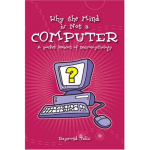 This week’s New Scientist has a fascinating article on a possible ‘grand theory’ of the brain that suggests that virtually all brain functions can be modelled with Bayesian statistics – an approach discovered by an 18th century vicar.
This week’s New Scientist has a fascinating article on a possible ‘grand theory’ of the brain that suggests that virtually all brain functions can be modelled with Bayesian statistics – an approach discovered by an 18th century vicar.
Bayesian statistics allow the belief in the hypothesis to shift as new evidence is collected. This means the same evidence can have a different influence on certainty, depending on how much other evidence there is.
In other words, it asks the question ‘what is the probability of the belief being true, given the data so far?’.
The NewSci article looks at the work neuroscientist Karl Friston, who increasingly believes that from the level of neurons to the level of circuits, the brain operates as if it uses Bayesian statistics.
The essential idea is that the brain makes models upon which it bases predictions, and these models and predictions are updated in a Bayesian like-way as new information becomes available
Over the past decade, neuroscientists have found that real brains seem to work in this way. In perception and learning experiments, for example, people tend to make estimates – of the location or speed of a moving object, say – in a way that fits with Bayesian probability theory. There’s also evidence that the brain makes internal predictions and updates them in a Bayesian manner. When you listen to someone talking, for example, your brain isn’t simply receiving information, it also predicts what it expects to hear and constantly revises its predictions based on what information comes next. These predictions strongly influence what you actually hear, allowing you, for instance, to make sense of distorted or partially obscured speech.
In fact, making predictions and re-evaluating them seems to be a universal feature of the brain. At all times your brain is weighing its inputs and comparing them with internal predictions in order to make sense of the world. “It’s a general computational principle that can explain how the brain handles problems ranging from low-level perception to high-level cognition,” says Alex Pouget, a computational neuroscientist at the University of Rochester in New York.
Friston is renowned for having a solid grasp of both high-level neuroscience and statistics. In fact, he’s was the original creator of SPM, probably the most popular tool for statistically analysing brain scan data.
Needless to say, his ideas have been quite influential and ‘Bayesian fever’ has swept the research centre where he works.
I was interested to see that his colleague, neuroscientist Chris Frith, has applied the idea to psychopathology and will be arguing that delusions and hallucinations can be both understood as the breakdown of Bayesian inference in an upcoming lecture in London.
This edition of NewSci also has a great article on how cosmic rays affect the brains of astronauts, so it’s well worth a look.
Link to NewSci article ‘Is this a unified theory of the brain?’.
Link to article ‘Space particles play with the mind’.
 The BPS Research Digest has just
The BPS Research Digest has just  Magnetic resonance imaging is the most popular method for scanning the brain both for research and for clinical investigations. I’ve just found a wonderfully written
Magnetic resonance imaging is the most popular method for scanning the brain both for research and for clinical investigations. I’ve just found a wonderfully written 
 The New York Times have an
The New York Times have an 
 The last few months have seen the passing of
The last few months have seen the passing of  The
The  In light of research showing that an ingredient in cannabis, cannabidiol, seems to actually reduce the risk of psychosis, I speculated
In light of research showing that an ingredient in cannabis, cannabidiol, seems to actually reduce the risk of psychosis, I speculated  The New York Times
The New York Times  A quote from the sardonic
A quote from the sardonic  The Boston Globe has a provocative
The Boston Globe has a provocative  Neurophilosophy has
Neurophilosophy has  Horror movie
Horror movie  Today’s
Today’s  On the Ropes, BBC Radio 4’s programme about people in difficult situations,
On the Ropes, BBC Radio 4’s programme about people in difficult situations,